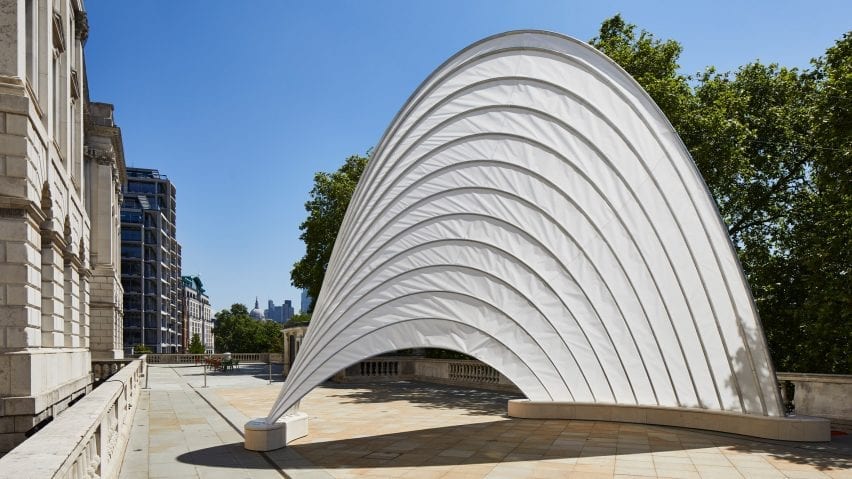
Ini Archibong creates Pavilion of the African Diaspora "for the black voices leading us into the future"
In an exclusive interview, designer Ini Archibong says he is glad that people are waking up to issues of racial inequality and hopes that his London Design Biennale pavilion will provide a platform for conversation.
The Pavilion of the African Diaspora – which was first announced in a live interview for Dezeen's Virtual Design Festival last year – opened this week as one of 38 projects on show at Somerset House for the 2021 edition of the biennale.
Taking the form of a sail, it is the first of three follies that Archibong is creating for the project, with other structures due to be unveiled in New York and Miami later this year.
It will be used as a stage for talks, events and performances from members of the African Diaspora.
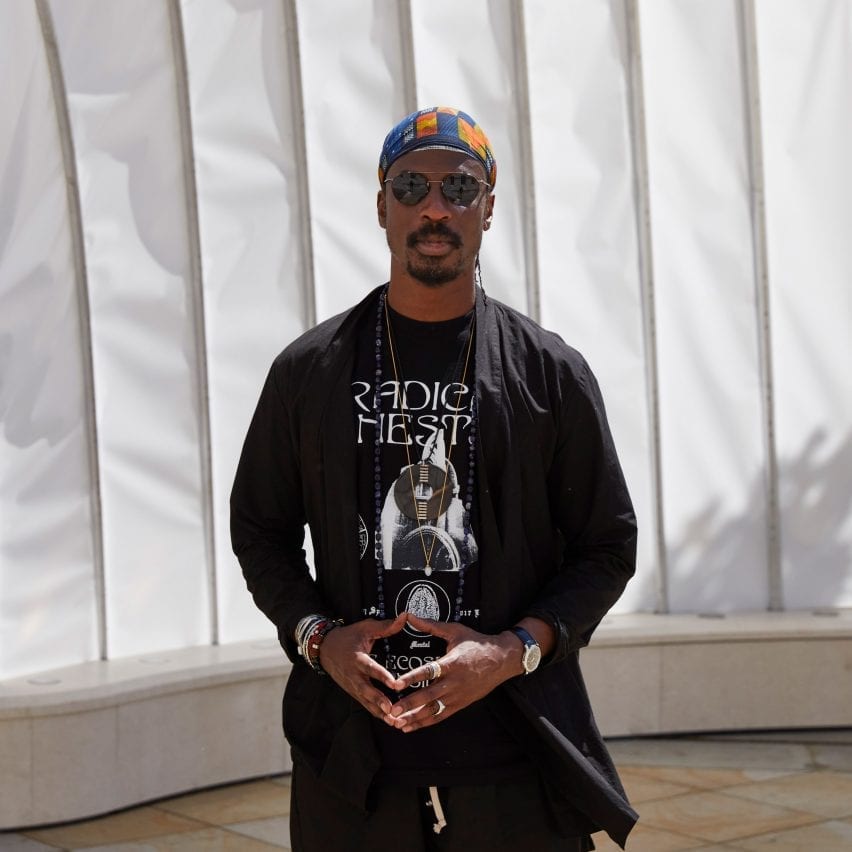
Archibong told Dezeen that, although the project comes in the wake of the Black Lives Matter movement, it is not intended as a statement about race, but instead as a place where people of African descent can come together and share stories.
"This is meant to be a platform for the people in the diaspora to have a conversation," he said. "This isn't a platform for Ini to express his views on race. It was never intended to be that and it won't become that."
Representing something bigger
The African diaspora refers to Africans and their descendants who have settled away from the continent, as a result of migration or slavery.
Archibong, who was raised in the US by Nigerian parents, but who is now based in Switzerland, says he felt a responsibility to represent his heritage at the biennale, particularly considering the lack of racial diversity in the design industry.
"We don't often have somebody that's in my position be asked to put something into a biennale, or that even gets to be a designer on the international stage," he said.
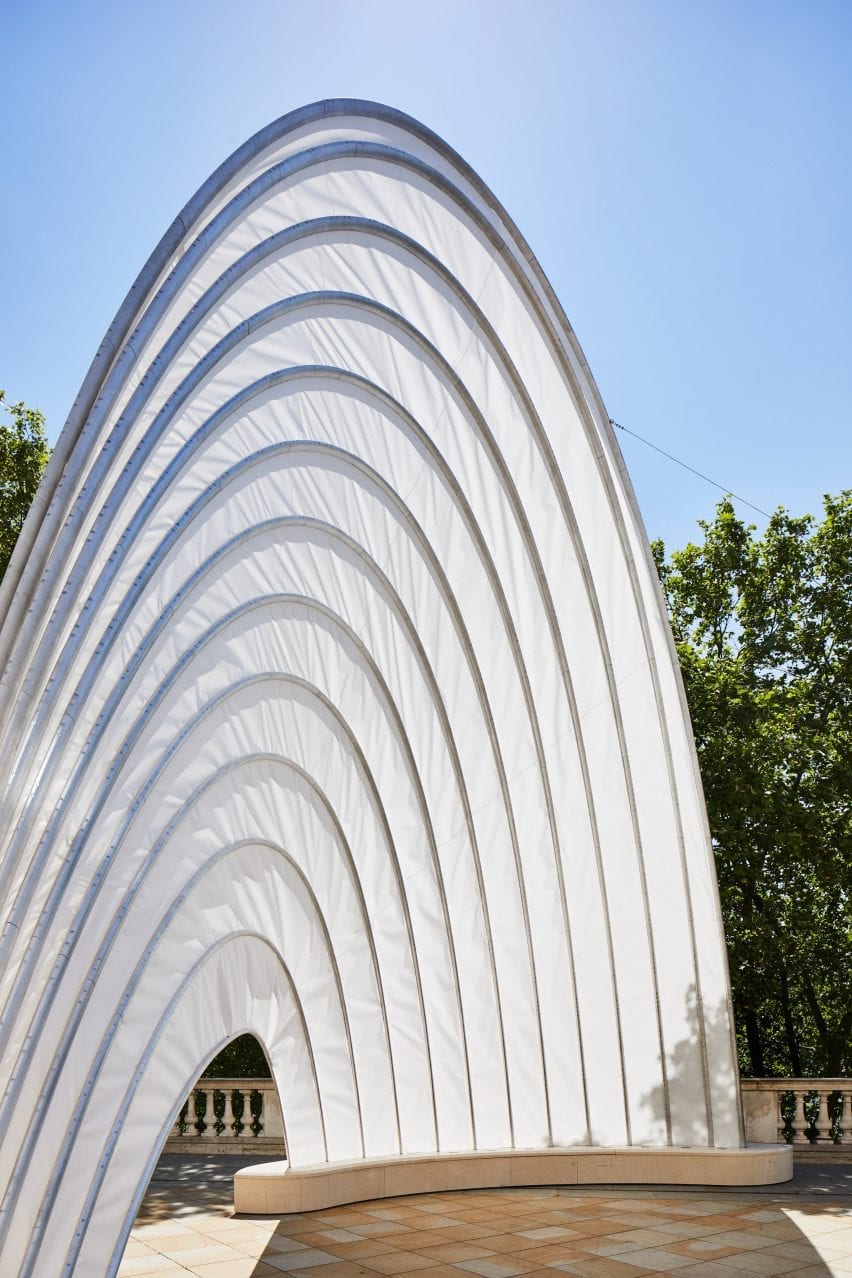
Archibong points out that the pavilion was first conceived in 2019, well before Black Lives Matter gained momentum. But he believes the connection with this movement, as well as other organisations like The Movement for Black Lives, will help this project reach a broader audience.
"I'm proud that its execution came at a time when it can represent something bigger to a lot more people than just the design community," he said.
"One could say it's an act of defiance"
By creating a pavilion specifically for members of the diaspora, he hopes to draw attention to the lack of monuments and public spaces designed for people of colour, and the important role they play in making cities more inclusive.
He describes it as "a temporary monument in the seat of the home of the transatlantic slave trade out of the UK, dedicated to the people that were enslaved".
"One could say it's an act of defiance, one could decide to look at it as divisive if they chose to," he said. "But I just presented it as exactly what it is and how people take it is how they take it."
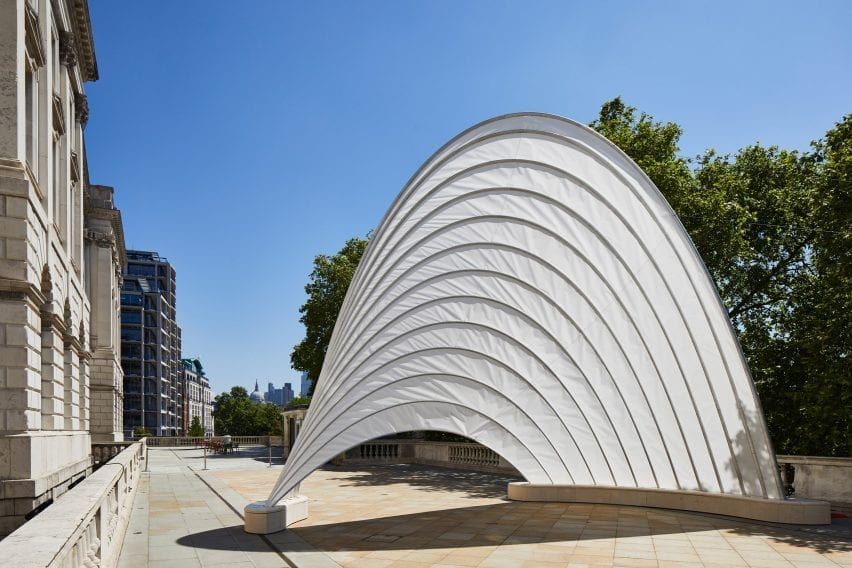
"If it is divisive, it's divisive in the sense of saying that there are going to be people that accept us and they are going to be people that don't, and that's a division that I'm completely okay with," he added.
In London, New York and Miami
The structure on show at Somerset House is named The Sail, while The Wave will debut in New York in the autumn and The Shell will feature at Art Basel in Miami in December.
These structures all take inspiration from the forms of conch and cowrie shells, which not only have symbolic meaning in various diasporic cultures, but can also represent the idea of resonating voices. Other inspirations include sound waves, ship sails and thresholds.
"After you've crossed this threshold and entered into the space of The Sail, you see these sound waves overtaking The Sail and carrying us into the future," said Archibong.
"In a sense, it represents a mythological pass, and a through line, for the black voices leading us into the future."
Legacy for the future
The 2021 edition of the London Design Biennale is curated by Es Devlin, with the theme Resonance. The exhibition – which also features Forest for Change, an installation of 400 trees – is on show from 1 to 27 June at Somerset House.
Throughout the biennale, the Pavilion of the African Diaspora will host a programme of events centred around contributions from the African Diaspora, curated with the help of managing partner Tamara N Houston.
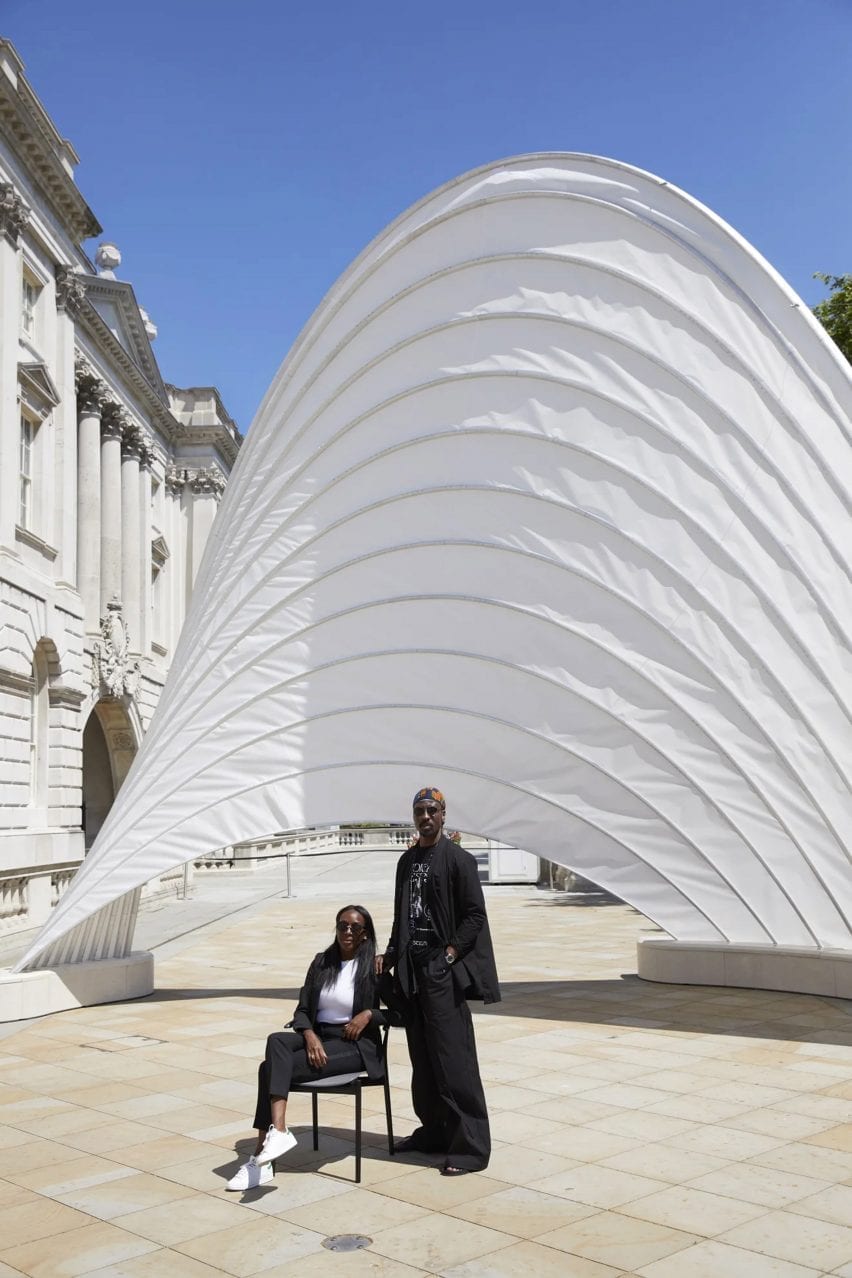
Archibong said he hopes that pavilion can have a legacy for the future, possibly in helping to create more cultural support for the African diaspora worldwide.
"Looking at the diaspora as a global whole isn't something that we do very often," he said. "It would be great if that was one of the outcomes."
Read on to see the edited interview in full:
Amy Frearson: What led you to create the Pavilion of the African Diaspora?
Ini Archibong: When Es Devlin first explained the theme for the biennale, the wheels started turning from the beginning. It didn't take long for me to come up with the concept.
I started to tell her this story about resonance, coming out of a shell, representing the African diaspora, and how I felt about the rise of nationalism, and about the nature of borders and flags, and what they mean for someone of African descent. We both walked away from those conversations feeling like this was important and needed to be done.
Amy Frearson: You hadn't particularly addressed race or identity in your work before this. What was it about this project that made you feel it was the right time to address these topics?
Ini Archibong: My identity has always been infused in my work, I just never saw the need to speak about it before. One of the things that's essential to my core philosophy is this idea of unification. If I had spent the first 10 years of my career talking about how different I was to everybody else, rather than presenting them with work that was different and presenting it in a way that they were able to digest it, then I would have been working against my intent and my goal.
I have spent 10 years creating objects and experiences which expressed core philosophies that came to me from my heritage. I think if people look back at my work now, knowing what has gone into it, it might spark some different conversations.
There's also the fact that I was asked to do something that had to do with my identity. Being asked to design for the London Design Biennale, it immediately became about what country I was going to represent. That was the reason why this conversation got started. People might get confused because of the timing, but Es and I started this conversation well before the design community started taking an extreme interest in the works of people of colour.
The concept didn't come about because of the work of the Black Lives Matter organisation or any of the other organisations that are fighting for justice. But it was and is catalysed by all of the work that organisations like Black Lives Matter and The Movement for Black Lives are doing to bring attention to these issues. I'm proud that its execution came at a time when it can represent something bigger to a lot more people than just the design community.
Amy Frearson: Can you tell me more about how the Black Lives Matter movement impacted the way the project developed, and also how you felt about it?
Ini Archibong: It affected it in a few ways, and probably some unexpected ways. The project almost didn't come about, because certain energies had to be focused elsewhere. There was more important stuff going on than necessarily getting this done. There were times, especially at the beginning of last year and through the summer, when there were more important places for me to be utilising resources than on trying to build this pavilion. So in that sense, it was affected.
In another sense, there became a lot more motivation for me to share my perspective. In conceiving this project, I was not planning to necessarily get so in depth about exactly how I feel about these topics. This is meant to be a platform for the people in the diaspora to have a conversation.
This isn't a platform for Ini to express his views on race. It was never intended to be that and it won't become that. But because of what has been happening, it's important for me to use my position, as somebody who has been asked to express themself, in a way that is beneficial to my people. So in that sense, it hasn't necessarily changed the pavilion or the intent of the pavilion, but it has had an effect on how I, as a person, address the topic of race.
Amy Frearson: Do you see this as a turning point, that you're moving from simply being a black designer in a predominantly white industry, to being a black designer who has a voice and a message to express?
Ini Archibong: I can see how it could be seen that way, but I don't necessarily think that. Me making this pavilion and me speaking about these topics right now might be the last time that I address any of this publicly. I don't know what's going to happen in the future, but with the number of interviews that I've done about this topic just surrounding the pavilion, I'm not sure that there's much more that I need to say.
Everything that I do is rooted in who I am. So, for anybody that's paying attention, there's always been a thread of my culture there. It doesn't necessarily mean that I'll be using my work to discuss topics of this nature. I've always dealt with topics of this nature just not in the public way and I'll continue to do what I need to do, the way that I see fit, but not necessarily through the objects that I create.
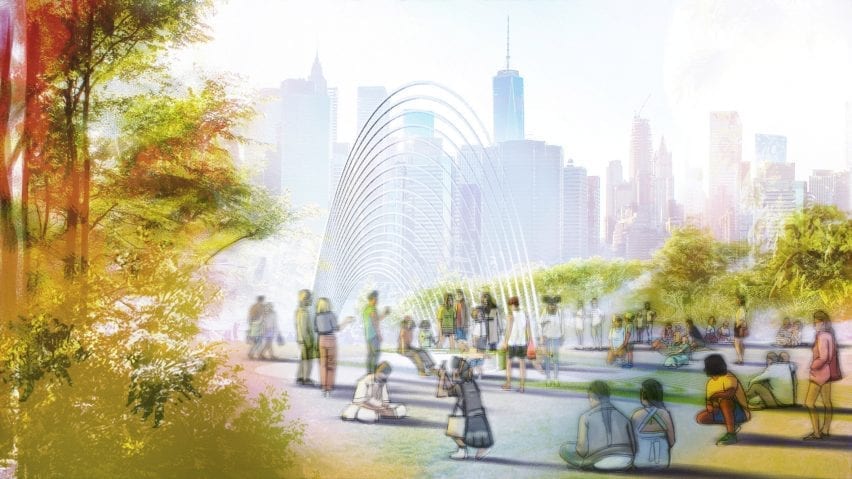
Amy Frearson: How did you approach creating a space to represent such a diverse range of people, with so many different experiences?
Ini Archibong: You can't really type African diaspora inspirations into Google, so you have to make your own references. I purposely went for abstract representations of things that are somewhat familiar, that have meaning within the African diaspora. I didn't have to be accurate in my envisioning. There's no way to actually assess how well I executed a representation, because there's not really a canon of things that are said to be of the unified diaspora. So in that sense, it gave me the opportunity to create from scratch.
I created a mythology and created what would be the important elements of that mythology, like in foreign languages, to tell the story. Then I executed it on a monumental scale. It was actually easier than if I'd had to do a deep dive into the specific histories and meanings of very specific places. I was able to take a zoomed-out view and say, what are things that are commonly understood or representational across the African diaspora? Then I got to make my own story and imagine the artefacts.
Amy Frearson: Is that what led you to this concept of the conch or cowrie shell?
Ini Archibong: The mythology started with the brief. The theme was resonance; when I thought about what that meant, and the power that sonic resonance could hold in an idealised dream world, what I came to was that the vibrations of black voices could be a rallying call to people far and wide.
That's how I came up with the shell. In different cultures of the diaspora, the conch shell and the cowrie shell have different importance, but for almost all of them, the conch shell is representative of a trumpet or horn of some kind, while the cowrie shell represents trade, commerce and being productive. I took these two things as inspiration to create this mythological shell that began to craft the story of what these forms would be.
Thinking about the resonating voices coming out of that shell, how do you then visualise that? The motif of concentrically spreading arcs and arches is commonly understood to represent the spreading of sound waves. So that instantly created the second folly. You have the shell and then you have the wave gate. It's a gate because thresholds are important in my work.
As a spiritual method, they represent being one thing at one point, and then becoming something new after you've crossed that threshold. After you've crossed this threshold and entered into the space of the sail, you see these sound waves overtaking the sail and carrying us into the future. In a sense it represents a mythological pass, and a through line, for the black voices leading us into the future.
Amy Frearson: How much did your own personal experiences of race and identity feed into this narrative? Do you see this as a personal project?
Ini Archibong: It is and it isn't. I wouldn't be doing this for the African diaspora if I hadn't had the experiences that I've had, growing up as the child of Nigerian immigrants in America, then going to live all around the world. That is a specifically diasporic experience that led me to want to create something like this. And then on the flip side, none of it is really personal; it's based on a mythology that I created from scratch.
So the impetus to do the project was extremely personal, but the work is not that personal. Everything else about it is from the people in whatever city that it's in. That's the programming. There's diasporic programming for the diaspora here in London. In New York, it will be for the people of New York. In Miami, it will be the people of Miami. but I can't personally take credit for much except having an idea and creating the space for the magic to happen.
Amy Frearson: You first proposed the idea in a live interview on Dezeen, before you'd been formally invited to participate in the biennale. What kind of response did that trigger?
Ini Archibong: Some might say we were ill-advised to announce it on Dezeen; even the drawings that we showed were just preliminary sketches about ideas that we didn't even know how we were going to use. But it was important to say that it was coming because it put a timeline on things and a responsibility to get it done.
I've had nothing but positive responses. I think the most appreciated ones are from the people of the diaspora that are working in this building, that have been watching it get erected, that feel proud that it's there. Then meeting people throughout the city, inviting them to come check out the pavilion, and showing them the renderings and images. Those are some of the most gratifying responses.
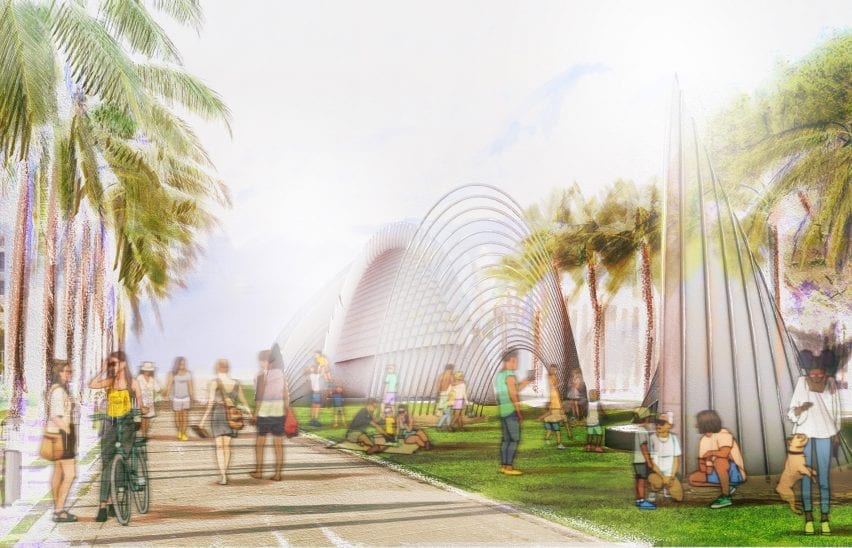
Amy Frearson: Do you think it would have had the same response if you'd created it before the Black Lives Matter movement? Do you think people other than those of the African diaspora would have been able to understand the purpose and need as clearly as they do now?
Ini Archibong: I think for sure it would have had a different reception from the people outside of the diaspora. But I didn't necessarily make it for the people outside of the diaspora. I'm glad that people are paying attention and are able to understand better the importance of something like this.
But I think that the people that I created it for would have appreciated it back then or now or anytime. Because we don't often have somebody that's in my position be asked to put something into a biennale, or that even gets to be a designer on the international stage.
Amy Frearson: The Black Lives Matter movement has proved surprisingly divisive in some circumstances. Did you have that in mind when developing this project? Were you conscious of putting a positive spin on the conversation?
Ini Archibong: No, it wasn't a purposeful thing. I think by nature I am, hopefully, an optimist. With the Black Lives Matter organisation, The Movement for Black Lives organisation and all the different organisations that are part of this movement for equality and justice, I see everything that they're doing as positive. I don't really see it as divisive. I'm creating a monument here.
It's a temporary monument in the seat of the home of the transatlantic slave trade out of the UK, dedicated to the people that were enslaved. One could say it's an act of defiance, one could decide to look at it as divisive if they chose to. But I just presented it as exactly what it is and how people take it is how they take it.
If it is divisive, it's divisive in the sense of saying that there are going to be people that accept us and they are going to be people that don't, and that's a division that I'm completely okay with.
Amy Frearson: You mentioned previously that you had difficulties funding the project and pointed to the lack of centralised institutions or organisations to represent the African Diaspora. Do you think this project could help to change that, to help the African diaspora develop a stronger voice of representation?
Ini Archibong: I hope so. But I'm very clear on what I do and where my skill set lies. I created the platform and the venue for the conversation. I hope that one of the outcomes of that conversation could be creating organisations that address and support the diaspora. I think the biggest issue that we have is that the diasporas are disconnected.
There are organisations in support of the continent of Africa. You might have an organisation that supports the diaspora in the UK or in the US, as African Americans, but looking at the diaspora as a global whole isn't something that we do very often. It would be great if that was one of the outcomes.
Amy Frearson: What would you say is the most important message of the project?
Ini Archibong: I want people to be happy to have a place to gather; a place to assemble. We don't have those. We don't have monuments that are about us. The message that I hope comes out of this is the power of placemaking in monument erection.
Photography is by Ed Reeve.
The London Design Biennale 2021 takes place from 1 to 27 June at Somerset House. See Dezeen Events Guide for an up-to-date list of architecture and design events taking place around the world.